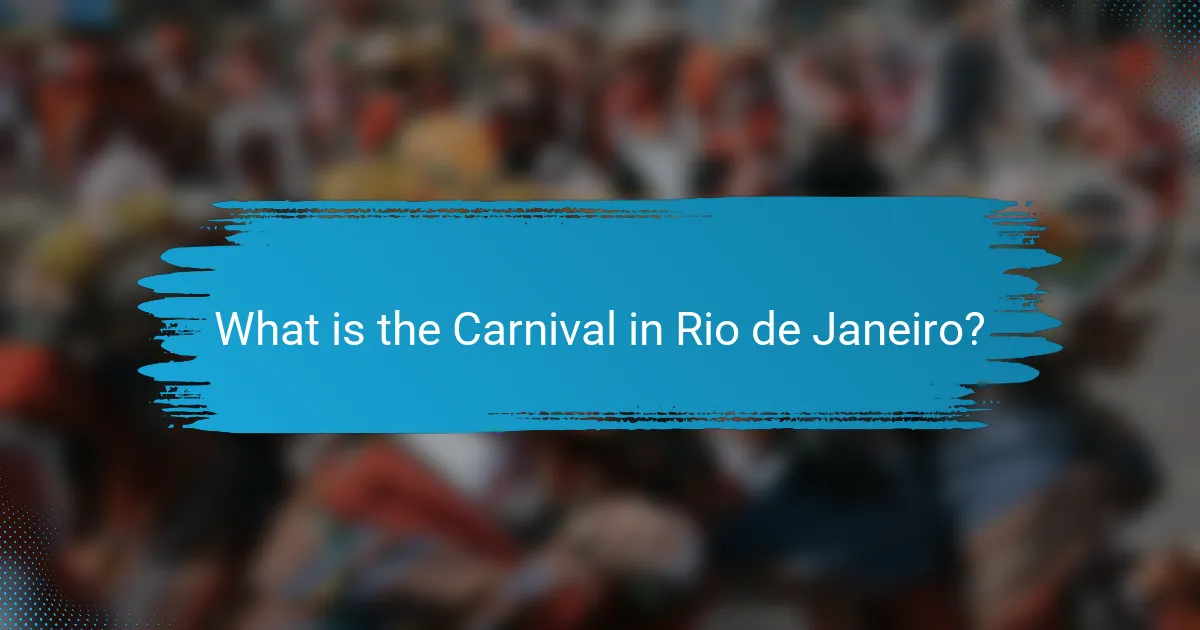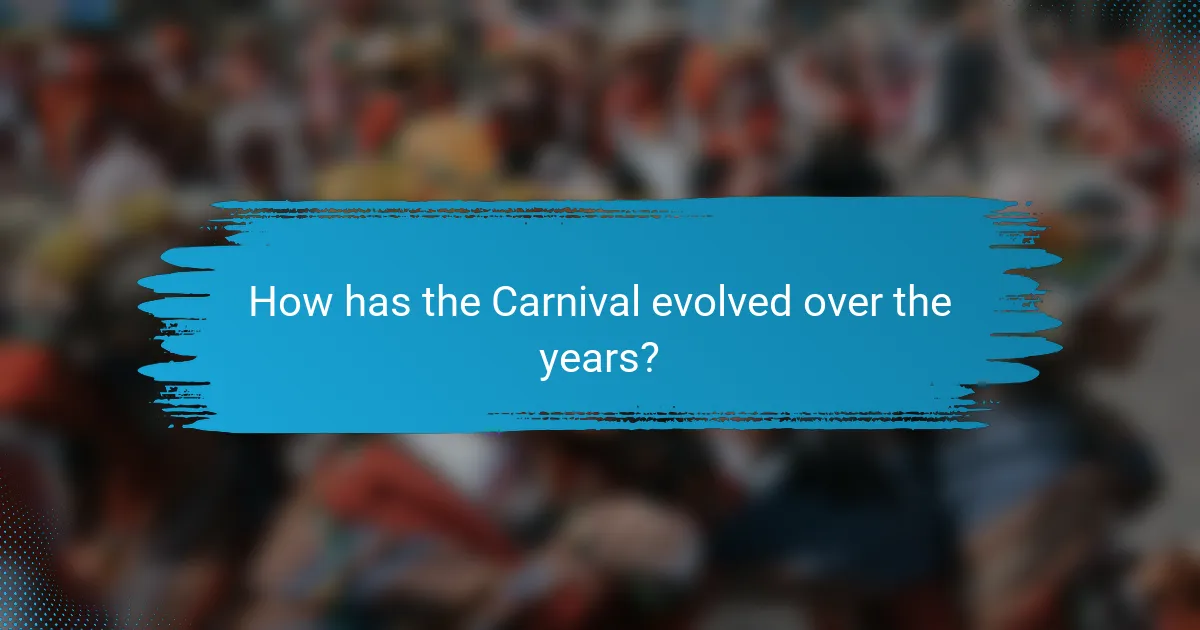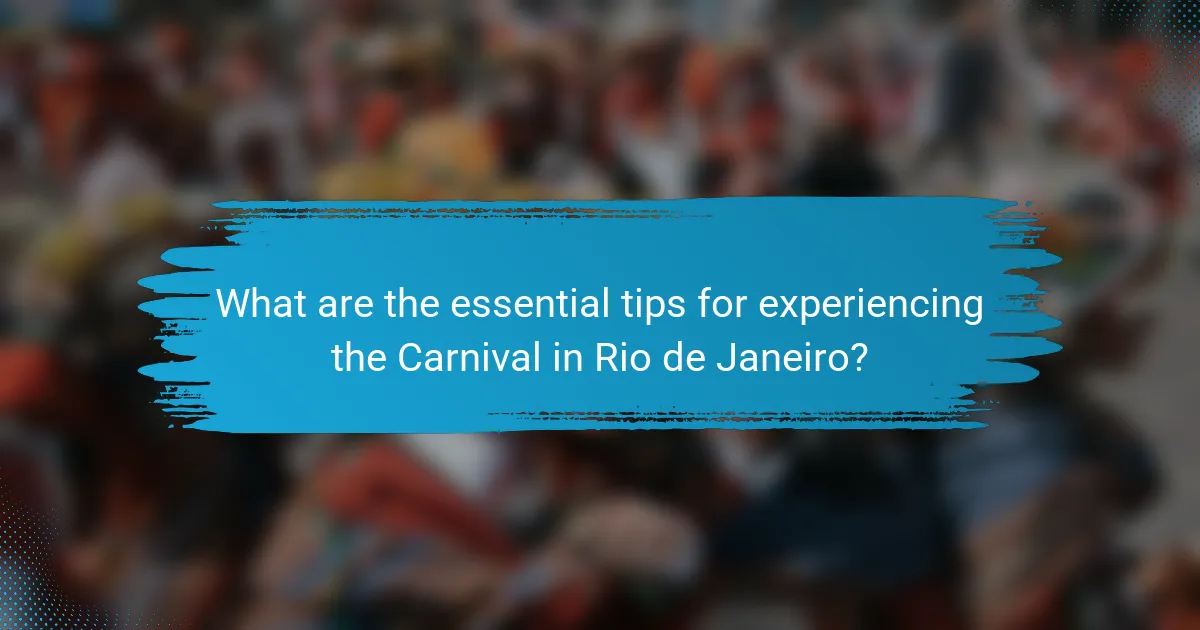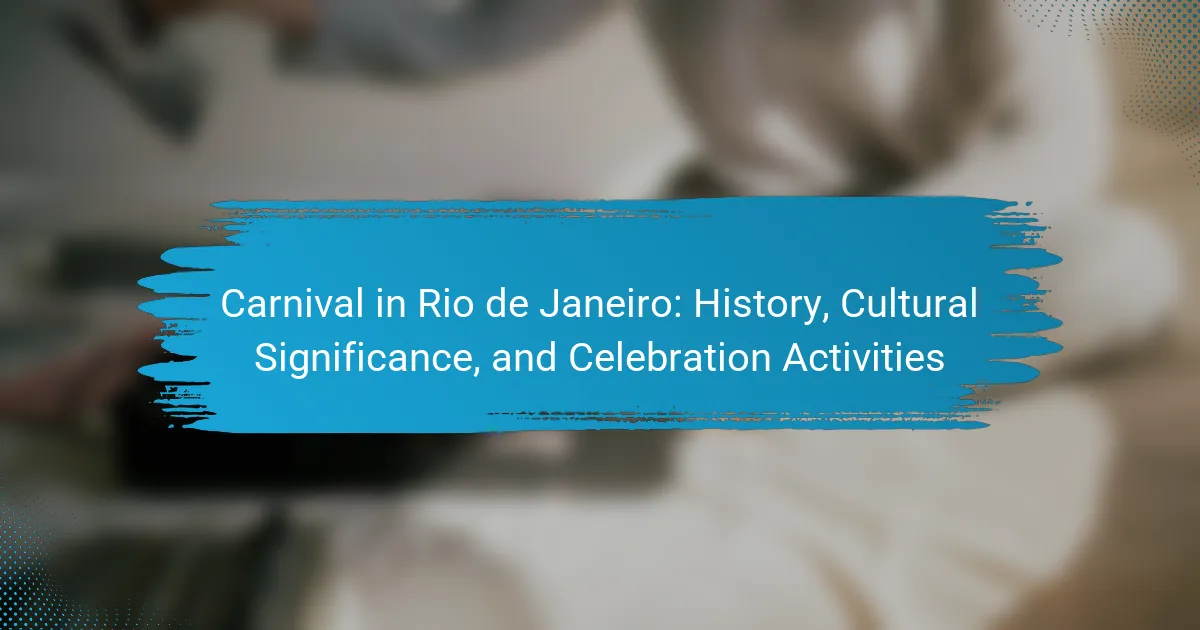The Carnival in Rio de Janeiro is an iconic annual festival celebrated before Lent, renowned for its vibrant parades, samba music, and elaborate costumes. With historical roots tracing back to the 18th century, the event reflects a blend of African, Indigenous, and Portuguese cultural influences. Millions of visitors attend each year, experiencing the competitive parades at the Sambadrome and lively street parties known as “blocos.” Recognized as a UNESCO Intangible Cultural Heritage, the Carnival has evolved significantly, with samba becoming its defining musical genre and samba schools formalizing competition. To fully enjoy the festival, visitors are advised to plan ahead, secure accommodations, and immerse themselves in the local culture through various activities.

What is the Carnival in Rio de Janeiro?
The Carnival in Rio de Janeiro is a world-famous festival held annually before Lent. It features vibrant parades, samba music, and elaborate costumes. The event attracts millions of visitors each year. Historical roots trace back to the 18th century. It combines African, Indigenous, and Portuguese cultural influences. Samba schools compete in spectacular parades at the Sambadrome. The festival is known for its lively street parties called “blocos.” Carnival in Rio is recognized as a UNESCO Intangible Cultural Heritage.
How did the Carnival in Rio de Janeiro originate?
The Carnival in Rio de Janeiro originated from Portuguese colonial traditions. It began as a pre-Lenten festival in the 18th century. The celebration combined European customs with African and Indigenous influences. Initially, it featured masked balls and street parties. Over time, samba music became integral to the festivities. The first organized samba school parades occurred in the 1930s. Today, Carnival is a world-renowned event attracting millions of participants and spectators. It showcases vibrant parades, elaborate costumes, and cultural expressions unique to Brazil.
What historical events influenced the development of the Carnival?
The development of Carnival was influenced by several historical events. The origins trace back to ancient Roman festivals, such as Saturnalia, which celebrated the end of winter. These festivities included feasting, masquerades, and social role reversals. In the 17th century, the Catholic [censured] integrated Carnival into Christian traditions before Lent. This incorporation led to the establishment of pre-Lenten celebrations. The arrival of African slaves in Brazil also shaped Carnival, introducing unique rhythms and dances. The blending of indigenous, African, and European cultures created diverse expressions of Carnival. The first official Rio de Janeiro Carnival took place in 1840, marking its evolution into a significant cultural event. The abolition of slavery in 1888 further influenced Carnival, as formerly enslaved people contributed to its growth and diversity.
Who were the key figures in the early history of the Carnival?
The key figures in the early history of Carnival include prominent individuals such as King Momo and the various samba schools’ founders. King Momo is often regarded as the symbolic king of Carnival, representing joy and festivity. His role is central to the celebrations, as he officially opens the Carnival festivities. Founders of samba schools, like Ismael Silva and Cartola, played crucial roles in shaping samba music and dance. Their contributions helped establish samba as the heartbeat of Carnival in Rio de Janeiro. These figures created a cultural foundation that continues to influence Carnival today.
What are the cultural significances of the Carnival in Rio de Janeiro?
The Carnival in Rio de Janeiro holds significant cultural importance as it embodies Brazilian identity and heritage. It serves as a platform for artistic expression through samba music and dance. The event unites diverse communities, fostering social cohesion and cultural exchange. Historically, Carnival has roots in African, Indigenous, and European traditions, reflecting Brazil’s multicultural society. It attracts millions of participants and tourists, boosting the local economy. The vibrant parades and costumes showcase creativity and craftsmanship. Carnival also promotes cultural pride and continuity, preserving traditional practices. Overall, it is a celebration of life, joy, and unity in diversity.
How does the Carnival reflect Brazilian cultural diversity?
The Carnival reflects Brazilian cultural diversity through its vibrant mix of music, dance, and traditions. Participants showcase influences from African, Indigenous, and European cultures. Samba, a key genre of Carnival, has roots in African rhythms and was developed in Brazil. The use of colorful costumes represents various cultural heritages. Parades highlight regional differences, featuring distinct styles and themes. Local communities engage in the celebration, emphasizing inclusivity and social cohesion. According to the Brazilian Institute of Geography and Statistics, over 1 million people participate annually, illustrating its widespread cultural significance. This diversity fosters a sense of national identity while celebrating local traditions.
What role does the Carnival play in Brazilian identity?
The Carnival is a crucial element of Brazilian identity. It embodies the country’s rich cultural diversity and social unity. The event showcases various musical genres, including samba, which is integral to Brazilian culture. Carnival celebrations involve elaborate parades, colorful costumes, and vibrant street parties. These elements reflect Brazil’s historical influences from African, Indigenous, and European cultures. Additionally, Carnival serves as a platform for social commentary and political expression. Many participants use this opportunity to address societal issues through art and performance. The festival attracts millions of tourists, promoting Brazil’s global image. Thus, Carnival is not only a celebration but also a significant expression of national identity.
What are the main celebration activities during the Carnival?
The main celebration activities during the Carnival include parades, street parties, and samba competitions. Parades feature elaborate floats and costumes, showcasing cultural themes. The Sambadrome hosts the most famous samba school competitions, attracting thousands of spectators. Street parties, known as “blocos,” occur throughout Rio, inviting locals and tourists to join in the festivities. Music plays a central role, with live bands and DJs performing popular tunes. Dance is integral, as participants express joy through samba and other dance forms. Food and drink vendors provide traditional Brazilian cuisine and beverages, enhancing the festive atmosphere. These activities collectively create a vibrant celebration that reflects Rio’s rich cultural heritage.
What types of parades are featured in the Carnival?
The Carnival features several types of parades. The main types include samba school parades, street parades, and blocos. Samba school parades are grand events held in the Sambadrome. These parades showcase elaborate floats and costumes. Street parades occur throughout the city and are more informal. Blocos are smaller, community-focused parades that celebrate local culture. Each type of parade contributes to the vibrant atmosphere of Carnival. Together, they attract millions of participants and spectators annually.
How do samba schools contribute to the Carnival experience?
Samba schools play a crucial role in shaping the Carnival experience. They organize parades that feature elaborate floats and costumes. Each school represents a unique theme, showcasing cultural narratives and historical events. The performances include rhythmic samba music and dance, engaging thousands of participants and spectators. Samba schools also foster community spirit by involving local residents in the preparation and festivities. They contribute to the competitive aspect of Carnival, with awards given for the best performances. This competition drives creativity and innovation in choreography and design. The influence of samba schools extends beyond Carnival, promoting Brazilian culture year-round.

How has the Carnival evolved over the years?
The Carnival in Rio de Janeiro has evolved significantly since its inception. Originally, it began as a European-style festival in the 18th century. The event incorporated African and indigenous influences over time. By the 20th century, samba became the defining musical genre of the Carnival. The introduction of samba schools in the 1920s formalized the competition aspect of the event. Today, Carnival features elaborate parades, vibrant costumes, and international participation. Attendance has grown, with millions of visitors each year. The event now serves as a symbol of Brazilian culture and national identity.
What changes have occurred in the Carnival’s celebrations?
Carnival celebrations in Rio de Janeiro have evolved significantly over the years. Traditional samba parades have become more elaborate, featuring larger floats and more intricate costumes. The inclusion of international music genres has diversified the soundscape of the festivities. Additionally, there has been a rise in street parties, known as blocos, which attract a younger audience. The use of social media has changed how events are promoted and experienced. In recent years, there has been a greater emphasis on inclusivity and representation within the celebrations. Environmental concerns have also led to initiatives aimed at reducing waste during the festivities. These changes reflect broader cultural shifts within Brazilian society.
How have modern influences shaped the Carnival experience?
Modern influences have significantly shaped the Carnival experience by integrating global styles and technologies. The infusion of international music genres, such as electronic dance music, has transformed traditional samba rhythms. This blend attracts a younger audience and enhances the festival’s appeal. Social media platforms play a crucial role in promoting events and engaging participants. They facilitate real-time sharing of experiences, making Carnival a global spectacle. Additionally, the incorporation of contemporary fashion trends influences costume designs. This evolution reflects societal changes and artistic expressions. Furthermore, the rise of tourism has led to commercialized aspects of the celebration. This commercialization impacts the authenticity of local traditions while providing economic benefits. Overall, modern influences have redefined the Carnival experience, balancing tradition with innovation.
What technological advancements have impacted the Carnival?
Technological advancements have significantly impacted the Carnival in Rio de Janeiro. Innovations in sound systems have enhanced music quality during parades. High-definition video displays allow for stunning visual effects. Advanced lighting technology creates vibrant atmospheres at night. Social media platforms facilitate broader audience engagement and participation. Mobile applications streamline event information and scheduling for attendees. Drones capture aerial footage, providing unique perspectives of the festivities. Wearable technology enables real-time tracking of participants and crowd management. These advancements have transformed the overall experience, making it more immersive and accessible.
What challenges has the Carnival faced in recent years?
The Carnival in Rio de Janeiro has faced significant challenges in recent years. The COVID-19 pandemic severely impacted the event, leading to cancellations and restrictions. In 2020, the Carnival was postponed due to health concerns. In 2021, many events were canceled or scaled down to ensure safety. Economic difficulties have also affected funding and participation. Many samba schools struggled financially, impacting their ability to prepare for the event. Additionally, social issues, such as crime and violence, have posed challenges for organizers and attendees. These factors have led to a decline in attendance and overall participation in the festivities.
How has the COVID-19 pandemic affected the Carnival?
The COVID-19 pandemic significantly impacted the Carnival in Rio de Janeiro. In 2021, the event was canceled for the first time in over a century. This decision was made to prevent the spread of the virus among large crowds. The cancellation affected local economies reliant on tourism and festivities. Many samba schools faced financial difficulties due to the loss of revenue. In 2022, Carnival returned but with reduced capacity and health protocols. Participants were required to wear masks and maintain social distancing. The pandemic altered the traditional vibrant atmosphere, creating a more subdued celebration. These changes reflected ongoing concerns about public health and safety.
What measures are being taken to ensure the Carnival’s future?
Measures to ensure the Carnival’s future include increased funding and community engagement. The government has allocated resources for infrastructure improvements. Local organizations are promoting cultural education to preserve traditions. Sustainability initiatives are being implemented to reduce environmental impact. Partnerships with private sponsors are being formed to enhance financial support. Efforts are underway to promote tourism year-round, not just during the Carnival. These strategies aim to strengthen the Carnival’s cultural significance and economic viability for future generations.

What are the essential tips for experiencing the Carnival in Rio de Janeiro?
To experience the Carnival in Rio de Janeiro, plan your visit well in advance. Book accommodations early, as they fill up quickly. Familiarize yourself with the event schedule, including parades and blocos. Dress comfortably and wear festive clothing, often in bright colors. Stay hydrated and enjoy local food and drinks, like caipirinhas and street food. Use public transportation to navigate the city efficiently. Be mindful of your belongings to ensure safety in crowded areas. Lastly, immerse yourself in the local culture by participating in samba workshops or street parties.
How can visitors prepare for the Carnival festivities?
Visitors can prepare for the Carnival festivities by planning their itinerary in advance. They should research the schedule of events and parades. Booking accommodations early is essential due to high demand. Visitors should also consider purchasing tickets for popular events ahead of time. Understanding local customs and traditions enhances the experience. Packing appropriate clothing, such as costumes or festive attire, is important. Staying hydrated and maintaining energy levels during the festivities is crucial. Finally, learning basic Portuguese phrases can improve communication with locals.
What should attendees know about safety during the Carnival?
Attendees should prioritize personal safety during the Carnival. They should stay aware of their surroundings at all times. It is advisable to travel in groups rather than alone. Keeping personal belongings secure and close is essential. Additionally, attendees should avoid displaying valuable items openly. Staying hydrated and protecting against the sun is important for health. Following local laws and regulations enhances safety. Emergency contact numbers should be readily available in case of incidents.
How can one best enjoy the music and dance at the Carnival?
To best enjoy the music and dance at the Carnival, immerse yourself in the vibrant atmosphere. Engage with the performers and dancers to feel the energy. Arrive early to secure a good viewing spot for parades. Participate in the street parties to experience local rhythms. Dress in colorful costumes to blend in with the festivities. Stay hydrated and take breaks to maintain your energy. The Carnival features samba music, which is central to the experience. Historical records show that samba originated in the early 20th century and is integral to Carnival celebrations.
What are the must-see events and attractions during the Carnival?
The must-see events and attractions during the Carnival in Rio de Janeiro include the Sambadrome parades, street parties, and blocos. The Sambadrome hosts elaborate samba school parades showcasing vibrant costumes and choreography. These parades occur over several nights and attract thousands of spectators. Street parties, known as blocos, take place throughout the city, featuring live music and dancing. Each bloco has its own unique theme and attracts diverse crowds. The Carnival also includes the famous street carnival in neighborhoods like Santa Teresa and Lapa. These areas are known for their lively atmosphere and local celebrations. Additionally, the iconic [censured] the Redeemer statue offers a stunning backdrop for Carnival festivities. It is a symbol of the city and a popular tourist attraction during this time.
Which neighborhoods are best for experiencing the Carnival atmosphere?
The best neighborhoods for experiencing the Carnival atmosphere in Rio de Janeiro are Sambadrome, Lapa, Ipanema, and Copacabana. Sambadrome hosts the main parades, showcasing elaborate floats and samba schools. Lapa is known for its vibrant street parties and live music. Ipanema features beach parties with a festive vibe, attracting both locals and tourists. Copacabana offers a lively beachfront celebration, complete with fireworks and performances. Each neighborhood provides a unique perspective on the Carnival, enhancing the overall experience.
What are the best practices for enjoying the parades and street parties?
Arrive early to secure a good viewing spot for parades and street parties. Bring essentials like water, snacks, and sunscreen to stay hydrated and protected. Wear comfortable clothing and shoes suitable for standing and dancing. Respect local customs and follow safety guidelines provided by organizers. Engage with performers and fellow attendees to enhance the experience. Be mindful of your belongings to avoid theft in crowded areas. Utilize public transportation to navigate the city efficiently during events. These practices ensure a safe and enjoyable experience at Rio de Janeiro’s Carnival celebrations.
Carnival in Rio de Janeiro is a globally recognized festival celebrated annually before Lent, featuring vibrant parades, samba music, and elaborate costumes that reflect Brazil’s rich cultural diversity. The event has historical roots dating back to the 18th century, influenced by Portuguese colonial traditions and shaped by African and Indigenous cultures. Key elements include samba school competitions at the Sambadrome, lively street parties known as “blocos,” and a strong emphasis on community participation and artistic expression. This article explores the origins, cultural significance, celebration activities, and challenges faced by Carnival, providing a comprehensive understanding of its role in Brazilian identity and heritage.
